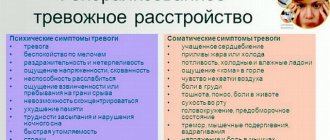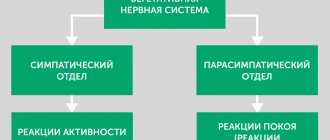A panic attack, also called episodic paroxysmal anxiety, is a special type of anxiety disorder that usually occurs due to stress. They happen suddenly and are accompanied by intense fear, increased heart rate, trembling, shortness of breath, increased sweating and a feeling that something terrible is about to happen. This condition is very difficult for a person to tolerate and in 70% of cases is complicated by depressive states and the occurrence of suicidal thoughts.
What it is
A panic attack is a causeless, debilitating attack of panic or anxiety, accompanied by a feeling of fear and various physiological symptoms.
To understand what a person feels at such moments, imagine the situation. You are walking down the street and suddenly notice that a huge dog is rushing towards you at a frantic pace. There is an ominous grin on his face, his gums are exposed and his sharp, huge fangs are visible. Drool splashes in all directions, and rage and malice are visible in his eyes. How do you feel?
Of course, you will experience incredible fear, you will feel that your heart has stopped, your legs have become weak, and sweat has appeared on your forehead. People experiencing a panic attack feel about the same thing. But there is a colossal difference between you and them: in your case there is a real threat to life, while for them there is no objective danger. That is, their fears are not supported by anything.
However, this is only at first glance; such individuals can say that the attack began suddenly. In further conversation with them, it turns out that panic was preceded by traveling in an elevator or public transport, being in a place with a large crowd of people or on an airplane, or other similar reasons.
The concept of “panic” originates from the name of the god Pan, the lord of fields, forests and herds. According to legends, he suddenly appeared before a person covered in fur and with goat legs, plunging the latter into uncontrollable fear. The man started to run, not knowing where, along the edge of a cliff, not realizing that flight could also threaten death.
In the literature one can find the concepts of vegetative or sympathoadrenal crisis, cardioneurosis. They are identical to the term “panic attack.”
Why does a panic attack happen?
The reasons for this condition have not been fully elucidated. There are many prerequisites and provoking factors that can theoretically cause such a hypertrophied feeling of anxiety.
They are divided into biological, psychological and physiological.
Biological reasons include:
- hormonal changes during puberty, menopause, childbirth;
- beginning of sexual life;
- menstrual irregularities;
- heredity.
Panic attacks develop against the background of certain disorders:
- pheochromocytoma – hormonal tumor;
- psychosomatic disorders;
- phobias;
- depression;
- post-traumatic stress disorder;
- endocrine diseases;
- heart pathologies.
Among the psychological precursors of the condition are:
- acute stress - death of a loved one, divorce, any negative sudden situation;
- identification or opposition of oneself to any subject - the hero of a film, book, etc.;
- isolation from society;
- character traits;
- childhood experience.
As for character traits, most often panic attacks accompany women with a hysterical, demonstrative personality type. They constantly attract attention and crave recognition. Such women often have an extravagant appearance, are pretentious and very expressive. If they notice that they are not of interest to the “victim,” they very quickly switch to another object.
Men suffering from this disease exhibit traits called “health hypochondria.” They care very much about their appearance and strive to always look perfect.
Stress experienced in childhood also contributes to the development of attacks of fear already at a conscious age. One of the common causes is alcoholism in the family, which provokes situations of aggression. It could be a fight, a risk of murder. The situation becomes so acute that they have to flee home, often at night. In this case, fear is fixed, and in adulthood, in similar situations, it is repeated in such an impartial manner, intensified several times.
Another example is families where children grow up in conditions of emotional poverty and coldness. When parents or a parent (if we are talking about a single-parent family) are so passionate about themselves and their work that they simply don’t get around to the child. Or in the case when someone close to you suffers from a serious illness, everything revolves around the sick person, and they simply forget about the child.
Emotional coldness towards a child is present where too great demands are placed on him. At the same time, parents can keep the child under super control, but, at the same time, not show warmth and kindness towards him. Adults raised in such circumstances constantly seek approval and emotional support. Their stress resistance is significantly reduced.
The third model of family behavior is the opposite of the previous one and is based on overprotection of the child. At the same time, his parents are constantly worried about his condition, regarding any situation as potentially dangerous. They control literally all areas of their “blood” and try to accompany him everywhere. By doing this, they support the child’s infantilism, which leads to difficulties in social adaptation.
Constant conflicts in the family develop emotional lability in the child. The inability to influence the situation provokes confidence in one’s helplessness.
Any of the listed models lead to the fact that such a child grows into an adult who is emotionally unstable, insecure, and has difficulty interacting with society. This reduces his resistance to stress, exposing him to all sorts of mental disorders.
In addition to family conflicts, violence experienced in childhood, sexual or physical, contributes to the development of panic attack syndrome.
Physiological factors that provoke an attack include abuse of alcoholic beverages and psychostimulants, physical fatigue, weather changes, and excess solar radiation.
The incredibly talented actor Johnny Depp suffers from panic attacks. According to him, since childhood he has experienced anxiety in any non-standard situation. And the choice of his eccentric roles is nothing more than an attempt to hide his essence in front of millions of viewers.
Consequences
Panic attacks significantly worsen a person’s quality of life and, if left untreated, can cause the following complications:
- self-isolation, fear of society, interruption of contacts with other people;
- decreased self-esteem;
- loss of confidence in the future;
- wariness, anxiety, which can provoke aggression towards the environment;
- sexual dysfunction;
- the formation of mental disorders with frequent repetition of attacks;
- conflicts in the family;
- problems at work, study;
- abuse of alcohol and drugs to combat panic;
- exacerbation of chronic diseases;
- disorders of the digestive tract, dystrophy due to refusal to eat due to anxiety;
- fear of death.
Signs of the syndrome
A panic attack usually develops suddenly. And he can find the patient anywhere, at any time of the day. Its manifestations vary: from an uncontrollable, painful feeling of fear and anxiety to internal discomfort. A panic attack with mild symptoms is called “panic without panic.” In this case, physiological symptoms dominate.
The duration of the attack may be only a few minutes, in other cases it lasts several hours. But on average its duration is 20–30 minutes. PAs are repeated in one situation 1–2 times a day, in others – several times a month. Having experienced such sensations for the first time, a person retains the memory of them for the rest of his life.
There is an incredible accident when a patient experiences attacks only a couple of times in his entire life. They disappear without a trace, presumably after the stress factor ends.
A panic attack is accompanied by the following symptoms:
| Psychological | Physiological (vegetative) |
|
|
The first case of a panic attack is expressed by an extremely strong fear of dying. Its power is so powerful that it can drive the patient into a state of passion. In subsequent cases, the feeling of imminent death is transformed into a specific phobia. This could be a fear of going crazy, suffocating, etc.
There are situations when the condition is not accompanied by an anxiety-phobic complex. Emotional symptoms come to the fore: apathy, a feeling of uselessness, aggression, nervousness.
After a paroxysm, patients feel exhausted and overwhelmed.
Panic attacks most often occur between the ages of 25 and 50. Approximately 5% of humanity suffers from the pathology. And what’s interesting is that they are mostly residents of large cities. In old age, such paroxysms occur rarely, have an erased character and become remnants of attacks that occurred in youth.
Those who have experienced a similar condition at least once in their lives describe it with horror and excitement.
For example, a girl had an attack while she was driving in a car with her husband and child. There was a feeling of lack of air, an unreal horror ran through from head to toe. In an instant there was a desire to open the door and jump out of the salon. The busy highway held me back.
Another patient was seized with fear when certain sounds appeared. I felt a nasty tingling sensation in my palms. Excitement sets in, causing your thoughts to become confused and your tongue to be taken away.
A woman described her husband experiencing a panic attack while they were walking in the park and talking about a relative who had recently had a heart attack. She noticed that her husband's arms and shoulders suddenly began to shake. He was covered in sweat, it was even dripping. His face turned pale, he practically stopped breathing (he couldn’t take a breath), his gaze was wandering and unconscious. The man was sure he was dying. It took almost 2 hours to get home, whereas it usually took 20 minutes. He constantly stopped, sat down on the ground, and the attack repeated.
Development mechanism
No one can reliably explain the pathogenesis of a panic attack. But there is a theory according to which the trigger is negative thoughts when they accidentally visit a person. Their action, akin to an objective threat, provokes the release of adrenaline and similar substances. They constrict blood vessels, causing increased heart rate and breathing. Blood pressure increases, and even in those who, in principle, do not suffer from this, the indicators reach 200 mm Hg. Art.
The amount of carbon dioxide in the blood decreases, and symptoms of hyperventilation, that is, breathing problems, increase. Receptors that cause excitation are stimulated and those responsible for inhibition are blocked. Thus, there is an increase in anxiety and panic symptoms and feelings of fear.
Many patients suffering from this disease are very afraid of losing consciousness. But in a panic crisis this is unlikely. All its development mechanisms indicate the opposite. In this state, the unconditioned “fight or flight” reflex is activated, which accompanies a frightening situation. In addition, high blood pressure and intense heartbeat simply will not allow you to do this.
Fear of fainting causes the patient to experience numbness in the limbs and dizziness. They are what confuse you.
2nd group. Life situations in which it is not possible to realize any important need.
At the same time, the way out of the situation most often, according to personal ideas, is not satisfactory. For example, you can highlight the following needs:
- personal safety;
- satisfying sexual relationships;
- significant position in society;
- self-realization in activities (profession, business);
- close emotional relationships with other people.
A job that doesn’t suit you can interfere with the satisfaction of important needs—let’s say, for some reason you don’t have the opportunity to change it. Or an environment that does not appreciate you and belittles your merits. A country where there is no opportunity to realize oneself. This state of affairs leads to an increase in internal tension and anxiety, which can also contribute to the occurrence of panic attacks.
I think you have noticed that in the current situation with coronavirus, many people have reasons from the two listed groups in their lives. If they were there before, then there could be more of them. Forced isolation, an imposed alien lifestyle, fear of getting sick and dying in relation to oneself and loved ones, loss of business, unpaid loans, loss of livelihood, uncertainty of the future, lack of objective and a large amount of negative information - all this does not contribute to peace of mind and mental health.
Whether panic disorder occurs or not depends on the characteristics of the individual and the traumatic situation, as well as the individual’s ability to independently cope with this situation.
If a panic attack does occur, then the following, third group of reasons is at work. In this case, they talk about triggers, that is, the reasons that directly trigger the attack. In this case, it is extremely important to correctly identify them and “cancel the launch.”
Night PA
A panic attack can strike a person at any moment, even at night. At night, in silence and in the dark, when the patient has nothing to distract himself with, he concentrates on his thoughts of a varied nature, including negative ones.
Another reason is nightmares. But do not confuse the attack itself with a terrifying dream. Paroxysm develops after a nightmare has been seen. And it cannot be forgotten, unlike a dream.
If we are talking about panic attacks of falling asleep, then they most often occur between 00.00–4.00 in the morning. The attack can also awaken its victim in the middle of sleep.
Nighttime PA significantly undermines human health. He suffers from sleep disorders, usually insomnia or problems falling asleep.
Insufficient rest at night provokes headaches and chronic fatigue during the day. The patient's productive activity decreases. He becomes nervous and irritable. The mood becomes depressive.
The symptoms of night attacks repeat the typical manifestations of the condition and also contribute to the development of phobias. So, after the death of her father, the girl began to have panic attacks. She noted that she experienced respiratory spasms at night. Often the thought appeared that he might not wake up. She even asked her friends to call in the morning to check if she was alive.
If a person, during a paroxysm at night, feels disconnected from reality and does not understand what is happening to him, then this feeling persists during the day. An exhausted nervous system that did not have time to recover overnight does not perceive objective reality. The patient does not understand who he is and what is happening to him.
A panic attack of awakening occurs early in the morning. The patient wakes up from a sudden and overwhelming feeling of anxiety. Gradually, other symptoms join in. Naturally, a person can no longer fall asleep, and he feels exhausted and unrested.
Drug therapy
Certain medications can help reduce some of the symptoms of a panic attack. If the patient’s brain has a disturbance in the exchange of neurotransmitters, the balance of the processes of excitation and inhibition, then they are prescribed much more than in milder cases.
At the first stage, medications relieve the attack, and then restore the functioning of various brain systems. They are able to eliminate the panic state altogether, or weaken it.
- Tranquilizers are prescribed at the very beginning of treatment and not for long, as they cause addiction. These drugs extinguish the severity of the attack, stabilize the autonomic system, and normalize sleep.
- Antidepressants require caution - you need to be careful about their contraindications, so the selection is strictly individual. It is interesting that similar products from different manufacturers can have different effects on the patient.
- Antipsychotics are used extremely rarely - only if panic disorder cannot be cured with other medications, as well as in the presence of a personality disorder or metabolic disorders in the brain. In addition, they are very difficult to find.
- Neurometabolic drugs are very active, so they are used strictly in courses and administered in the presence of a doctor. They allow you to reduce the doses of other psychotropic drugs.
It is necessary to emphasize once again that all of the above medications are prescribed personally. The doctor should pay special attention to their effect on the patient, especially in the first days, monitor the intake, cancel and re-prescribe in case of adverse events.
How to recognize the disease
Panic attacks, given the variety of its somatic symptoms, can masquerade as various organ diseases.
Most often, the patient feels like he is having a heart attack. Discomfort in the heart area is one of the most common phenomena among “alarmists”. They feel pain and tingling in the chest on the left side, palpitations. A pressing feeling appears, the heart seems to stop. But a regular ECG, echocardiography, ultrasound of the heart, 24-hour ECG and blood pressure monitoring can help rule out heart disease.
As for tachycardia, it is indeed present. But the reason for this is the activation of the sympathetic nervous system as a result of stress.
Another common condition that patients suspect is a stroke. Headaches, increased blood pressure, paresthesia in the form of tingling in the limbs, as well as changes in gait confuse him. The person gets very scared and even calls an ambulance.
The unrealistic fear that accompanies a patient with an attack separates him from reality. A person gets lost in space and does not perceive his surroundings. He fears that he will lose control of himself and do something unacceptable. He feels like he's going crazy. Because of this, such patients often fear that they are developing a mental disorder. Although mental problems can indeed appear. They are the result of a disorder.
Increased concern about one's health causes such a patient to develop hypochondria. He constantly visits all kinds of doctors, takes a whole bunch of tests. When specialists try to explain to him that the cause of his bodily discomfort is more psychological than physiological, they become irritated. And they go to another doctor in the hope that he will help them and get to the bottom of it.
Against the background of the disorder, depressive thoughts appear, since the person is really seriously concerned about his condition and does not know how to help himself.
Agoraphobia is a fear of open spaces or a specific place, literally “fear of the market square” can also become a complication of a panic attack. If the patient associates its occurrence with a certain place, then in the future he will avoid visiting it. A person may even be afraid to leave the house so as not to experience this painful feeling again.
Continuous, complicated attacks of PA can develop into panic disorder. To establish a diagnosis, the following criteria must be present:
- several severe attacks occur in a month;
- without a real threat;
- arises not only against the background of a predictable situation;
- non-anxious periods between attacks.
An important symptom of panic disorder is the constant anticipation of the next attack. In addition, the absence of the influence of psychostimulants (drugs, alcohol) is taken into account. Phobias and obsessive-compulsive disorder are excluded.
To confirm that the patient is really experiencing an attack of PA, and is not suffering from some real disease of the internal organs, the doctor is obliged to prescribe a series of examinations:
- ECG, ECG – monitoring; EEG;
- Ultrasound of the heart and other organs;
- radiography;
- CT, MRI;
- stomach examinations;
- blood test: CBC, liver tests, hormones:
- consultation of narrow specialists.
Conclusion
Panic attacks are often unreasonable fear and anxiety that arise under the influence of some traumatic factor on a person. The attack itself is not dangerous, but against the backdrop of uncontrollable fear, a person can commit rash acts, and frequent disorders disrupt his life. A constant feeling of fear and anxiety leads to insomnia, refusal to eat, severe exhaustion and exacerbation of chronic diseases. Panic attacks need to be treated and can be eliminated with psychotherapy, medication and lifestyle changes.
help yourself
At the moment when you are overtaken by an attack, it is very difficult to control yourself. But you can try to pull yourself together and help yourself get rid of it quickly:
- Go out into the fresh air or open the windows, unbutton tight clothes. Pour cool water over your face.
- It is important to switch to breathing. Try to breathe deeply, slowly and fully. To increase the level of carbon dioxide in the blood, breathe into a bag or cupped palms (imitate the position of breathing into them, trying to warm them up).
- Try to think about something positive or talk to someone. Try counting to 100 or count passing cars or trees if fear catches you in transport or on the street. All this helps to shift attention away from anxious feelings. If the cause of alarm is a certain place, hurry to leave it.
- To stabilize your body, place your hands on a stable surface or press your feet into the floor. This position will give you a feeling of confidence and control.
- Keep telling yourself that this will all end now. The anxiety that arises will not harm you, it is simply a figment of your imagination.
If you witness an attack on someone, you can help the person cope with the problem. The main thing: do not panic yourself! You must be calm. And with your calmness set an example for him.
Talk to him, hug him on the shoulder or squeeze his hand. Show me how to breathe correctly. If conditions permit, give the person water or warm tea.
The main thing is not to get confused in this situation. Remember, your behavior can significantly alleviate the panicker’s condition.
Treatment
Panic attacks disrupt a person’s life and also cause complications. To prevent them and return to a full life without anxiety and fear, you need to seek help from a doctor. Various methods are used in treatment, but the most effective is the combination of psychotherapy with medications.
Is treatment possible at home?
You can cope with attacks yourself by following these recommendations:
- find an “anchor”, a support that will allow you to take a stable position;
- Do breathing exercises regularly, and during an attack you can use some exercises or simply breathe into a paper bag;
- wear a bracelet that can be pulled back during an attack - the blow shifts the focus of attention, distracts from the trigger;
- remember pleasant moments, persuade yourself to calm down, try to shift your attention from the cause of anxiety;
- don’t be shy about asking for help; you can also repeat the names and contact details of your relatives out loud, which will allow you to coordinate those who are trying to help.
These recommendations will only help you cope with the symptoms of attacks, and will also teach you how to control them.
To completely eliminate the causes of the disorder, you need medical help, physical activity, a balanced diet, sleep, and giving up bad habits. Sometimes changing your type of activity, place of residence, or life attitudes helps to cope with anxiety and fear.
Drug treatment
Drug therapy is prescribed by a psychotherapist based on the patient’s condition and the severity of the attacks. Today, pharmacotherapy in the CIS countries is considered the most accessible, but not the most effective, since medications only help eliminate symptoms, while the trigger remains. During treatment, the doctor may prescribe the following groups of medications:
- Sedatives. Their effectiveness in treating panic attacks has not been proven. However, having medications with a sedative effect on hand can reduce anxiety and distract you, since for some, taking medications is a ritual with a powerful sedative effect.
- Tranquilizers. They are able to quickly cope with anxiety symptoms, eliminate fear, and stabilize mood. However, drugs in this group have many contraindications. They are prescribed in short courses, and dosages are selected individually.
- Neuroleptics. Helps cope with vegetative and mental symptoms of attacks.
- Nootropics. The effectiveness of these drugs has not been proven. There is an opinion that the use of nootropics for panic attacks increases mental and autonomic symptoms.
- Antidepressants are a group of drugs that have proven effective in treating anxiety disorders. Doctors prefer selective serotonin reuptake inhibitors, which are relatively safe and have minimal contraindications. The duration of taking antidepressants is individual - the minimum course is a month, and the maximum is 1 year.
Psychotherapy
Psychotherapy together with drug treatment will not only alleviate the condition and help you endure attacks more easily, but will also help you find the cause of anxiety and fear and cope with them. Cognitive-behavioral practice is most effective in treating panic attacks.
During treatment, the psychotherapist will help:
- find the causes of fear, anxiety, as well as risk factors, teach you how to control them;
- analyze thoughts and reasoning that destroy a person;
- learn self-help techniques;
- adjust behavior;
- motivate for recovery;
- resolve internal conflicts.
In addition to cognitive behavioral therapy, the following will also be effective: family therapy, psychoanalysis, art therapy, music therapy, animal therapy. In severe cases, hypnosis may be prescribed.
Phytotherapy
To alleviate the condition during attacks or the appearance of causeless fear and anxiety, herbs that have a sedative effect can be used at home. These include chamomile, valerian, mint, lemon balm, motherwort, St. John's wort, and linden. Based on these herbs, you can prepare soothing teas and drink them with honey.
Herbal medicine is not an independent method of treating panic attacks and can only be used as an auxiliary measure.
Breathing exercises
Breathing exercises help you relax and breathe normally, deeply, which is necessary during an attack. They can be performed anywhere at any time, as no additional equipment is required. The exercise is performed as follows:
- place one hand on your chest, the other on your stomach;
- take a deep breath through your nose, increasing the size of your belly, while your chest should remain motionless;
- As you exhale, tighten your abdominal muscles, slowly releasing the air.
Diaphragmatic breathing helps not only to calm down and relax, but also to stabilize blood pressure and eliminate other vegetative symptoms.
During the exercise, you may experience weakness and slight dizziness, which is normal and is associated with a decrease in blood pressure.
Physical exercise
In the fight against stress and normalization of the functions of the autonomic system, physical activity is effective, which promotes the release of endorphins into the blood. It is useful for people suffering from panic attacks to ride a bicycle, rollerblade, walk in the fresh air, or swim.
Meditation to relaxing, pleasant music is also effective. It is not necessary to have special skills. It is enough to sit on the floor with a straight back and close your eyes. Next, concentrate on breathing and think about the good, that the panic attacks will subside and will no longer bother you.
With proper treatment with psychotherapy, medications, and lifestyle changes, panic attacks can be managed forever.











